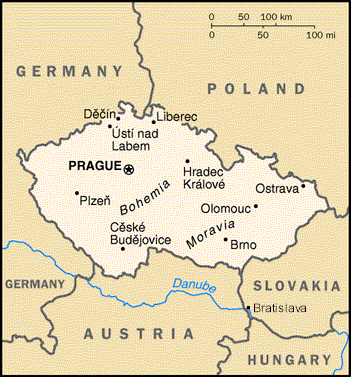

Status Quo Side: Czechoslovakian Government
Non-Status Quo Side: Various opposition groups
Region: Europe
Conflict Type: Primarily Internal
Issues in Dispute: Independence
Maps: UTexas maps
[Czechoslovakia
(Political) 1985 (250K)]
[Czech
Republic (Small Map) 1997 (49K)]
[Czech
Republic (Political) 1994 (209K)]
[Czech
Republic (Shaded Relief) 1994 (303K)]
[Slovakia
(Small Map) 1997 (62K)]
[Slovakia
(Political) 1994 (453K)]
Intermittent popular opposition during 45 years of Soviet-enforced communist rule continued as student groups organized forums and discussions of possible reforms, both illegally and through the official youth organization. By 1989, following profound changes in Soviet domestic and foreign policy including the implicit revocation of the Brezhnev Doctrine during revolutionary reform in Poland, talk of reform escalated among students and such established opposition groups as Charter 77.
A permitted student demonstration to honor the 50th anniversary of a Czech student martyr on November 17, 1989, which thousands attended, was violently suppressed by riot police as the crowd approached Wenceslas Square, killing one and injuring many. Next morning large numbers of students and others returned to the Square and a student group congregated in a theatre to consider further plans including a strike. Support from other diverse groups such as Charter 77 led to the formation of Civic Forum (CV) whose most prominent leader was dissident playwright Vaclav Havel. A sister Slovakian organization, People Against Violence (PAV) also formed. Within 3 days government leaders faced hundreds of thousands of demonstrators led by CV leaders, demanding widespread political and economic reforms. By day 8 the entire Politburo and Central Committee resigned. On day 10, direct negotiations with the Prime Minister began. On day 17 President Gustav Husak, having promised to end Party domination, announced a new cabinet, ostensibly "a broad coalition" although Communist party members numbered 16 among 21 proposed members. Huge demonstrations persisted including a successful general strike on November 27. On December 10 Husak resigned and the Federal Assembly elected Vaclav Havel to the office to lead the country to free parliamentary elections.
Following elections on June 8-9, in which Havel's Civic Forum and People Against Violence won a majority, Havel formed a new cabinet, "the government of national sacrifice" with a Slovak, Marian Calfa, as Prime Minister. Havel was reelected to the Presidency on July 5.
In 1992 Czechoslovakia was separated into two sovereign states, the Czech Republic and Slovakia.
[Library of Congress country
study of Czechoslovakia 1987]
[CIA Factbook for Czech
Republic 1998]
[CIA Factbook for Slovakia
1998]
Copyright © 1999 Lincoln P. Bloomfield and Allen Moulton